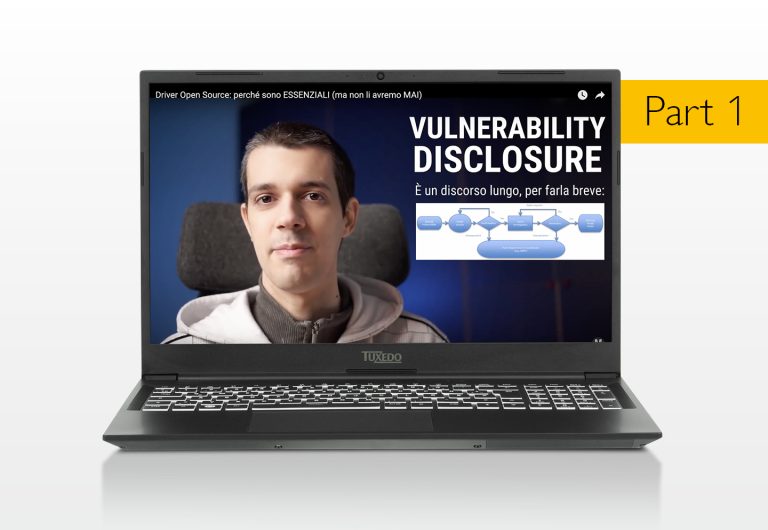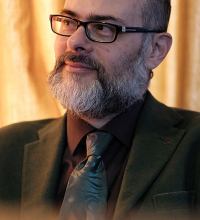The Secret of Morrolinux’s Success – Part 1: Evolution From the Beginnings

As we recently announced on this site, Morrolinux recently signed with the Linux Professional Institute (LPI) as a new Platinum Training Partner (ATP) for Italy.
Morrolinux is a one-man-project providing GNU/Linux and computer networking online training via Udemy, creating content with open source video-editing related tools, and handing all the setup, design, development, curation, and promotion for a YouTube Channel that can boast–as we are writing–65k subscribers
In this two-part series, LPI Community Manager Massimiliano “Max” Roveri, who has been involved in the set up of the partnership, interviews the man behind Morrolinux’s success, Moreno Razzoli, to share with you this amazing story from the Italian Linux and Open Source community.
Ciao, Moreno, and thank you for talking with us today. You are a very important voice in the Italian Linux community and, on top of that, you recently decided to become an LPI Partner. We thought the wider, global LPI community would be interested in your story. Let’s start with not “a” question, but “the” question: How has Linux changed your life? How, and when, did that change start to happen?
Anyone who has tried to use Linux as the primary OS on their PC knows that not everything always works, or works as well as we would like to, especially on a desktop. This was the paradox that changed my life (for the better!) in the long run. I installed my first distro in 2008: the brand new, shiny Ubuntu 8.04, which was a big step forward for GNU/Linux in terms of usability for a newbie (at the time) but still far from being perfect…I ran into a thousand problems.
OK, and how did you navigate those problems?
Even the most essential things I had always taken for granted just didn’t work; I couldn’t find the control panel and didn’t understand how to use the terminal. I often got angry, but I was so fascinated and attracted by the operating system that I soon realized I had already abandoned Windows for good. My transition was not a gradual one but a cold shower. Shortly afterwards, I decided to format the Windows partition to make room for a new installation of Linux.
And… what happened?
Well, I was formatting a lot. Sometimes the sound card or the microphone were not working, so I’d follow random guides, copying stuff from blogs and forums without even reading the postings, and pasting commands I didn’t understand into the terminal. Needless to say, most of the time I ended up with a system more broken than before. Then I would format. Or I would switch distros until I found the one on which the microphone would work. For a while, I have been using Mandriva for that reason alone. I didn’t even like KDE, but I had no idea that the Desktop Environment could be changed back then…
Keeping on making trouble and formatting to «fix» the troubles, I’ve learned to be patient and that taking the time to read and understand what you’re doing is the only way to go. Little by little, I learned to use search engines effectively, formulate questions correctly and understandably, and even solve some problems with the help of the forums.
By December 5, 2008, my only thought was to spread the good spell, let the world know that there is an amazing operating system called «GNU/Linux» that – even though I didn’t know it yet – would change the way I think about computing forever.
It seems quite a great feeling…
Indeed! I was at the top of the Dunning-Kruger curve. I had just learned a couple of terminal commands but I felt like Neo. It was time to open a YouTube channel.
In the following months, I started posting video tutorials on the things I had learned. Working on those tutorials, I discovered my passion for teaching: I was not only contributing to a good cause (GNU/Linux world domination), I was also helping other people intuitively understand complex concepts in a way I felt absolutely comfortable with. Using Linux also taught me the art of making do. Sometimes things are not as polished as in other operating systems, but this is not like any other operating system!
Free software is a bit like a canvas that is never completed. Don’t like something? You can change it. Need a particular feature? Create it yourself! Linux users are tireless problem solvers, and companies love that. If you’re the kind of person who learns best by doing, the FLOSS landscape is your heaven. I’ve lost count of how many projects I’ve adapted to my specific needs over time, but some of the most relevant ones I’ve shared on YouTube, and I hope they will inspire those who follow me to treat those projects as I have: Use them, break them, make them better. Then break them again!
Would you like to give us an insight into your YouTube channel?
In my videos, I want to convey to the audience as much as I can the enthusiasm I feel when I make a discovery or solve a real-world problem using the software. That’s why I rarely plan my content or spend time in the preliminary phase: My most successful videos are those in which there is as little time as possible between the idea and its realization. When it comes to conveying enthusiasm, my mantra is: Strike while the iron is hot!
Your channel is now very close to 65k subscribers. Do you feel like an influencer? What would being a Linux influencer actually mean?
I’ve always treated my channel as a bit of a show about what I’m passionate about in the world of computing, with a kind of down-to-earth attitude. When I post a video, my only goal is to spread the word about the topic to as many people as possible and maybe get a few more people interested. I don’t know whether that makes me an influencer–I’ve never considered myself one–but there’s an element of «influencing» in what I do because my videos often reflect my point of view. It’s not uncommon for someone in Italy to discover Linux by watching one of my videos or starting their FLOSS journey from the resources I post on my channel: I am always careful to use accessible terminology and inclusive language. Still, the cause I care most about is dispelling false myths about GNU/Linux and free software in general.
I can guess the relationship you have with your community is mainly a digital one: Do you have any “special” story from the interactions you have with it? And did you have any occasion for interacting with your community in the real world?
A few months ago, I started looking for accommodation in Milan, as I had to relocate for work reasons. I had mentioned this in one of my videos, and a person offered to help me with the search. We exchanged a few messages, and, after moving in, we met for a chat over a coffee. Mauro (not the real name) immediately made me feel welcome in a new and unexplored context, and it was really heartening to make his acquaintance. Before leaving, he said to me: «It’s me who has to thank you. Thanks to your courses, I got certified, passed the technical interviews at this important company, and left the old job that was killing me both morally and professionally.» These words will resonate with me for a long, long time.
The “other side of Morrolinux” is your activity on Udemy, where the users can find your courses for the LPI Certifications. What is your approach in designing the courseware? How do you connect the LPI-related materials of yours to the YouTube channel?
While designing the courseware, I always try to put myself in the shoes of a newbie. We have all been neophytes at some point: no one knows everything, and it is easy to forget this phase and its doubts and difficulties.
I am no exception, but I have the advantage of always having a large community to back me up: They weigh in through comments on YouTube or the Telegram group (morrolinux > /dev/null), where it is easy to find people of all ages, backgrounds, and experience exchanging opinions, advice, and pieces of information, but also asking for and providing help.
It’s the community feedback and activity that helps me stay close to the needs of more inexperienced users and, at the same time, find more exciting topics for more experienced users.
Each of my videos contains some element of GNU/Linux administration, from starting a service to changing the fstab or grub settings and so on. For instance, when I share with the community the latest gimmick or project I have made, I often also go into how I made it.
In this way, I don’t just provide ideas but apply them and put them in context, which in my opinion, is crucial. As the LPI program is, ultimately, a complete and well-structured manual for the far and wide administration of a GNU/Linux system, it’s natural that the topics I cover go hand in hand with the LPI certification program. But what makes my channel accessible is that to understand my videos you don’t need to follow my courses, because I always try to provide the basics within each video.
Of course, acquiring loose notions here and there in bits and pieces from a series of YouTube videos is not the best way to learn such a vast subject and obtain a solid foundation. But that is what my courses are for.
